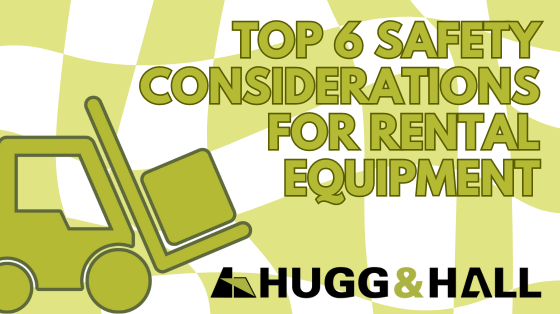
The Top 6 Safety Considerations for Rental Equipment
The only way to use rental equipment safely? Make sure everyone is trained. However, even if you’re a certified operator of equipment, chances are you’ll occasionally get a piece of rental equipment that will have you scratching your head. Whether it’s got an odd startup pattern, a unique feature, or something else, you need a way to ensure rental equipment safety. Follow these tips to ensure your jobsite is safe!
Variations in equipment models can impact how you operate the equipment. When you don’t feel confident on a specific machine, even if you’re certified to operate it, you’re more likely to make mistakes.
Before you start using the equipment for a job, familiarize yourself with the machine to anticipate any operational nuances.
You should always conduct a thorough inspection before you begin to operate equipment. While reputable rental companies like Hugg & Hall perform pre-rental inspections before they allow the equipment to leave the yard, it serves two purposes to do a second check:
- It promotes safety by ensuring some vital part of the equipment wasn’t damaged during transit.
- It helps you get more comfortable with the machine.
Some features you should check include:
- Brakes
- Lights
- Hydraulic lines
- Controls
By inspecting the equipment, you can help keep your jobsite safer.
Adherence to Occupational Safety and Health Administration (OSHA) regulations is vital to avoid fines, penalties, and legal liabilities.
If you’re a supervisor, you should ensure the equipment meets all required safety standards and that operators are trained accordingly.
Pay attention to any stickers or manuals that detail the equipment’s specified capabilities and limitations. Overloading or using equipment beyond its intended capacity can lead to accidents and damage.
One of the best parts of rental equipment is that you’re not on the hook for maintenance costs! But even rental equipment will still need maintenance from time to time.
As a preemptive approach, inquire with the rental company about the maintenance schedule for the equipment, especially if you’ll have it for an extended period of time. Properly maintained equipment operates more safely and efficiently.
As a reactive approach, when you notice something is broken down, or just operating differently than normal, always call your rental team right away to get the machine replaced. Faulty equipment can be incredibly dangerous.
Supervisors should equip their team with appropriate Personal Protective Equipment (PPE) based on the equipment being used and specific jobsite conditions. This includes helmets, gloves, safety glasses, and high-visibility vests.
Operators should know what PPE they need for a jobsite and refuse to operate equipment unless they have the appropriate PPE.
Supervisors and employees should prioritize safety in every aspect of construction projects. Regularly review and update safety procedures to reflect changes in equipment or jobsite conditions.
Ensuring all employees are trained, aware of safety protocols, and confident operating each type of equipment is the best way to have a safe jobsite.
Ready to prioritize rental equipment safety on your jobsite? Contact our training department today to schedule equipment-specific training sessions!
Back to News
Subscribe and unlock cutting-edge equipment insights, trends and tips!
Subscribe






